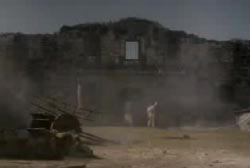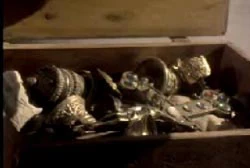
The Alamo
Case File: Alamo Treasure
Location: San Antonio, Texas
Date: 1836
Description: Originally known as the Mission San Antonio de Valero, the Alamo is a former Roman Catholic mission and fortress compound and the site of the famous battle in 1836. Built by the Spanish Franciscan priest, Antonio de Olivares, and Payaya Indians, it originally consisted of a sanctuary and surrounding buildings, was built for the education of local Native Americans after their conversion to Christianity. In 1793, it was secularized and then abandoned. Ten years later, it became a fortress housing a Spanish Army unit, the Second Flying Company of San Carlos de Parras. It is now a museum in the Alamo Plaza District of downtown San Antonio, Texas.
Case[]
History: Professional fortune hunter and historical researcher Frank Buschbacher believes that a fortune in gold remains hidden at the Alamo. According to legend, a treasure remains buried in the shadow of the Alamo's old mission, a secret which dates back to 1836, the year of the famous battle. It's believed that men led by Colonel James Bowie led a group of rugged frontiersmen across southern Texas to there. By some accounts, they were loaded down with a fortune in silver and gold called the "San Saba Treasure," said to be worth millions of dollars. It was intended to finance the Texas revolution for independence from Mexico, but two months later, Bowie and 188 other men with Davy Crockett made a courageous stand there against 6,000 well-trained Mexican troops. Not one of the defenders survived to tell the tale, but the legend of the treasure lived on.
Along with a team of archaeologists and researchers, Frank excavated the street in front of the Alamo. He first heard about the mysterious treasure there during a trip to Mexico, where was introduced to Maria Gomez, a respected museum curator who also had a reputation as a psychic. He had never heard of any treasure surrounding the battle, but she went on to describe the treasure as gold coins, silver, and religious artifacts. Some of it had been removed by Mexican soldiers, but that most of it still remained hidden there. She later drew him a map placing the treasure at the bottom of an old well. Even though she said she had never been there, she had indicated the spot where a well was dug just before the siege.

Alamo Treasure
At the time, the chapel was located in the rear of the fort. The well was in the plaza surrounded by twelve-foot tall stone walls. It was within them that the Texans held out for a full thirteen days. Frank believes that in a final desperate act, Bowie ordered that the treasure be hidden at the bottom of the well, but no one survived to retrieve it. Gail Loving-Barnes of the Daughters of the Republic of Texas doesn't believe in the treasure: "The people of the Alamo, I don't think they were guarding a treasure. When your life is on the line, like it was in the battle with Juno Santiana, I don't think you're thinking about silver or gold bullion. I think you're thinking about your life. And I don't think you would be polluting your water well because you don't know how long your siege is going to be."
Despite the controversy, Frank was determined to prove his point. In 1992, he obtained permission to survey the area with ground penetrating radar, yielding some intriguing results. To their trained eyes, its display showed several irregularities beneath the surface. The largest was believed to be the site of the well and in the exact location where Maria predicted the treasure would be found. "It kind of brought all my research to fruition at that point, because I knew that with the map, her story, and then plugging it in to Texas history that I was on a hot trail and any dissention that I had within my own mind about whether I should follow this any further was gone." Frank adds.
"The anomalies could be caused by many things," Gail counters. "I think it could be debris, equipment left by the Texans...I think it could be something several years later that was deposited there. As time marches on, dust and dirt accumulate and cover very gradually so that it could be part of what they're picking up out there." Frank believes that this treasure is located beneath the road in front of the Alamo, but to many native Texans, his theory doesn't hold up.
Project Director Thomas Guderjanhe of the Archaeology Department at St. Mary's University agreed to oversee the project in case anything that turned up had any historical value. It took Frank three and a half years to acquire the necessary permits and financing to excavate the site. On February 1, 1995, a 15x15 foot area was excavated above the well. A work crew needed to first remove three feet of flagstone and roadbed to reach the top of the filled-in well. Four feet beneath the surface of the courtyard, they began to find fragments of Native American pottery, the bones of butchered animals, and primitive cooking utensils. Each relic had to be carefully unearthed and properly cataloged. They are a valuable treasure in themselves, rare artifacts that help piece together a history of the Alamo from the 1750's right up to the final battle nearly a century later. One of the finds that most excited Thomas was some ammunition used in canons called grapeshot.
In the end, they found no sign of the treasure. Yet some remain convinced that it still exists somewhere deep beneath the Alamo.
Background: The Alamo is the former San Antonio de Valero Mission. It was founded as a Franciscan mission, but it is best known for the thirteen-day stand-off of General Antonio Lopez de Santa Anna's stand-off against the Mexican Army on March 6, 1836. Today, it is a national historic site.
Investigations: None
Extra Notes: This case first aired on the February 24, 1995 episode.
Results: Unsolved.
Links:
